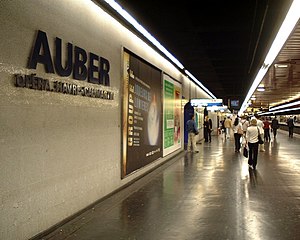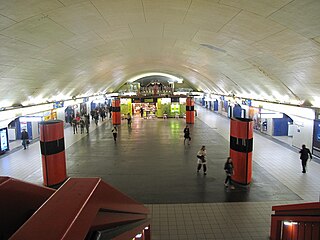Auber station
You can help expand this article with text translated from the corresponding article in French. (November 2022) Click [show] for important translation instructions.
|
Auber station (French pronunciation: [obɛːʁ]) is a station on RER A in Paris. Opened on 23 November 1971 and inaugurated during a ceremony by singers Dalida and Adamo, it is one of the largest vaulted underground stations in the world.
The station comprises a main train hall with a superposed ticket hall, together with an extensive network of tunnels connecting to the neighbouring Métro stations Opéra, Havre–Caumartin and Saint-Lazare, as well as Haussmann–Saint-Lazare on RER E. It takes its name from Rue Auber, under which it is situated. This street is in turn named after the mostly forgotten 19th-century composer Daniel Auber. A complete renovation of the station was started in 2017 and is due to be finished in 2022.
Engineering
[edit]Auber is built in the style of the traditional vaulted Métro station as pioneered by Fulgence Bienvenüe, with central tracks and lateral platforms. The difference in engineering terms is that Auber (along with Charles de Gaulle–Étoile and Nation stations) was constructed at depth, entirely underground, on a far larger scale than any Métro station.
To build the 225-metre long, 24-metre wide train hall and its even larger piggy-backing ticket hall, it was necessary to excavate a cavity 40-metre wide, 20-metre high and 250-metre long—this 30-metre underneath the busy city centre in unstable waterlogged sedimentary rock.[2]: 33 The resulting station is cathedral-like in proportions, with a ticket hall so spacious that there is room for a mezzanine. The entire construction is waterproofed on both sides by a 7-metre thick, 10-metre high abutment of concrete which contains escalators linking the two levels.[2]: 158
The station's eccentrically audacious scale and damp setting earned it references as "the world's largest submarine". With the other two deep single-vaulted stations on RER A it was retrospectively criticised on cost grounds. However, Auber is often mentioned as a good example of a planning policy attached to grand public spaces that was particularly current in the 1960s and in France.
Auber forms part of a complex of connected underground stations. The scale of Auber, in particular, makes the ensemble one of the largest underground stations in the world in terms of volume.
Particulate pollution
[edit]During busy periods, PM10 particle pollution caused by train braking regularly reaches 400 μg/m3 at Auber, eight times the EU Commission's daily average limit.[3]
Gallery
[edit]-
Ticket hall of Auber
-
Ticket hall of Auber
-
Main hall
-
Renovation of the main hall in January 2020
-
Renovation of the main hall in October 2020
See also
[edit]References
[edit]- ^ "Plan pour les voyageurs en fauteuil roulant" [Map for travelers in wheelchairs] (PDF). Île-de-France Mobilités. 2023. Retrieved 27 December 2023.
- ^ a b Gérondeau, Christian (2003). La Saga du RER et le maillon manquant. Presse de l'École nationale des ponts et chaussées. ISBN 2-85978-368-7.
- ^ "Les données | Plateforme opendata de la RATP". Archived from the original on 8 March 2013. Retrieved 24 March 2013.
External links
[edit]![]() Media related to Gare d'Auber at Wikimedia Commons
Media related to Gare d'Auber at Wikimedia Commons






